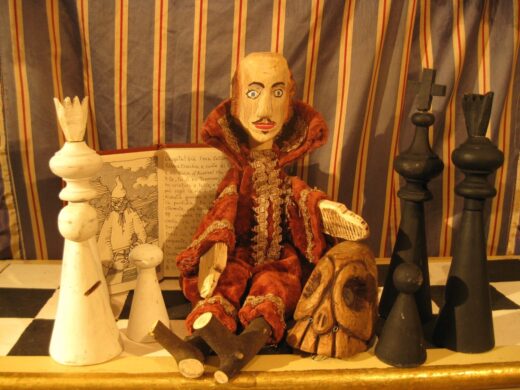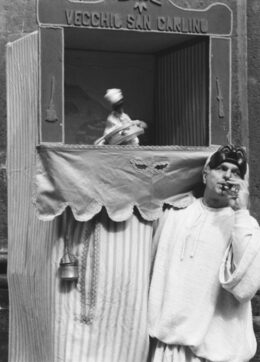
Manuscript
120 pages
Author(s)
Pulchi Shake and Speare
Miscellanea di drammi shakespeariani in guarattellesco by Pulcinella Cetrulo
Pulchi Shake and Speare. Miscellanea di drammi shakespeariani in guarattellesco by Pulcinella Cetrulo (Miscellanies of Shakespearean dramas performed in "guarattellian" by Pulcinella Cetrulo) is a show created by Bruno Leone in 2016 and presented in 2017 at the Napoli Teatro Festival. In this piece, Leone combines elements from several of William Shakespeare's tragedies and uses a variety of animation techniques: glove puppets, string puppets (marionettes), rod marionettes, marottes, objects. Leone also plays a flesh-and-blood Pulcinella and a puppeteer. A musician sings, plays various instruments and interacts with the flesh-and-blood Pulcinella. The protagonists of the various tragedies are interpreted with the swazzle. Some elements of the 2017 show (such as the final song) were not included in the 2016 manuscript.
Some characters kill each other
A flesh-and-blood Pulcinella speaks to the audience about his secret passion for books and, in particular, for Shakespeare's Macbeth. While reading a book and manipulating chess pieces on a small table in front of a castelet, Pulcinella tells the story of Macbeth. At the end, convinced that it's impossible for such a wicked character to die, he casts a spell to keep Macbeth alive. Pulcinella enters in the puppet boots and "Mr. Punch Macbeth" appears on stage.
After hitting his wife Judy and making a sausage with the Baby, Mr Punch-Macbeth meets Hamlet, played by a Pierrot puppet. In an absurd dialogue between the two characters, their stories mingle and Hamlet ends up killing Mr Punch-Macbeth, shouting, « Essere o non essere, non è un problema! » (« To be or not to be isn’t a problem! »). Hamlet falls in love with Juliette, but his brother (a Sicilian pupo) and the puppeteer prevent the marriage of a glove puppet and a marionette. Juliette drinks a potion which makes her appear to be
dead. Hamlet swallows a poison which turns him into a glove puppet representing Mobârak
(the black valet of the Iranian puppet theater), in the role of Othello.
Othello mistakes Juliette for Desdemona and kills her before remembering that he himself is Romeo. In despair, he commits suicide. Iago enters, interpreted by a puppet with the head of the Neapolitan actor Totò, and proclaims himself king of the wicked. But he is immediately
attacked and killed by a Polichinelle playing the part of Richard III. All the characters haunt the sleep of Polichinelle-Richard III: Mr Punch-Macbeth, Hamlet-Romeo, Othello, Iago. In the end, he is pursued by Death, but a horse with Pulcinella’s white hat and black half-mask comes to save him. At this moment, a marotte representing Shakespeare intervenes to bring the show to an end. Accompanied by the song Che cosa sono le nuvole? by Domenico Modugno and Pier Paolo Pasolini, taken from Pasolini's movie of the same name, the puppets make a final appearance on the puppet booth stage.
First performance
Napoli Teatro Festival, Villa Pignatelli
